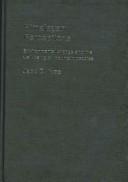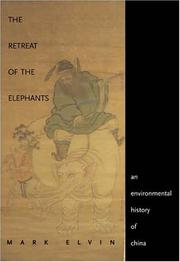| Listing 1 - 5 of 5 |
Sort by
|
Multi
ISBN: 2760518086 1435685784 9781435685789 9782760518087 2760513122 Year: 2004 Publisher: Sainte-Foy [Que.] : Presses de l'Université du Québec,
Abstract | Keywords | Export | Availability | Bookmark
 Loading...
Loading...Choose an application
- Reference Manager
- EndNote
- RefWorks (Direct export to RefWorks)
Depuis 1975, une colonisation agricole soutenue a littéralement bouleversé le paysage des montagnes et plateaux du Centre du Vietnam. Parmi les conséquences, les lisières forestières de cette région ont reculé, à un point tel que les forêts n'y apparaissent plus qu'à l'état résiduel. Cette dynamique a permis au nouvel État moderne vietnamien, issu des troubles politiques qui ont secoué la région de 1945 à 1975, de consolider sa présence partout sur son territoire en intégrant les populations et les territoires marginaux.
Land settlement --- Agriculture and state --- Deforestation --- Agricultural colonies --- Resettlement --- Settlement of land --- Colonies --- Land use, Rural --- Human settlements --- Conversion, Forest --- Depletion of forests --- Disforestation --- Forest conversion --- Forest depletion --- Forest-land conversion --- Clearing of land --- Forest fires --- Plants --- Labor colonies --- History. --- Extinction --- Cutover lands --- Colonisation intérieure --- Déboisement --- Terres déboisées --- Utilisation agricole du sol --- Politique agricole
Dissertation
ISBN: 9051130708 9085040329 Year: 2004 Publisher: Wageningen : Wageningen University,
Abstract | Keywords | Export | Availability | Bookmark
 Loading...
Loading...Choose an application
- Reference Manager
- EndNote
- RefWorks (Direct export to RefWorks)
Forêt tropicale humide --- Tropical rain forests --- Culture itinérante --- Shifting cultivation --- Fertilité du sol --- soil fertility --- Sol acide --- Acid soils --- Dégradation du sol --- Soil degradation --- Jachère --- fallow --- Chromolaena odorata --- Disponibilité d'élément nutritif --- Nutrient availability --- Faune du sol --- Soil fauna --- Compost --- Composts --- Fertilisation --- Fertilizer application --- Lumbricidae --- Légumineuse --- Legumes --- Cameroon --- Theses --- Composts. --- Bush fallow cultivation --- Cultivation, Shifting --- Forest fallow cultivation --- Shifting agriculture --- Slash and burn cultivation --- Swidden farming --- Agriculture --- Burning of land --- Clearing of land --- Cropping systems --- Fallowing --- Tillage --- Inga edulis

ISBN: 1134369085 1138867136 1280050888 0203597567 9780203597569 9780415317986 0415317983 9786610050888 6610050880 9781134369072 1134369077 0415317983 9781134369089 9781138867130 9781280050886 9781134369034 Year: 2004 Publisher: London ; New York : Routledge,
Abstract | Keywords | Export | Availability | Bookmark
 Loading...
Loading...Choose an application
- Reference Manager
- EndNote
- RefWorks (Direct export to RefWorks)
In the 1970s and 1980s many institutions, agencies and scholars believed that the Himalayan region was facing severe environmental disaster, due primarily to rapid growth in population that has caused extensive deforestation, which in turn has led to massive landsliding and soil erosion. This series of assumptions was first challenged in the book: The Himalayan Dilemma (1989: Ives and Messerli, Routledge). Nevertheless, the environmental crisis paradigm still commands considerable support, including logging bans in the mountain watersheds of China, India, and Thailand, and is constant
Human ecology --- Ethnoecology --- Mountain people --- Deforestation --- Culture and tourism --- Environmental degradation --- Environmental policy --- Degradation, Environmental --- Destruction, Environmental --- Deterioration, Environmental --- Environmental destruction --- Environmental deterioration --- Natural disasters --- Environmental quality --- Ethnotourism --- Tourism and culture --- Tourism --- Conversion, Forest --- Depletion of forests --- Disforestation --- Forest conversion --- Forest depletion --- Forest-land conversion --- Clearing of land --- Forest fires --- Plants --- Hill people --- Hillbillies --- Mountaineers (Ethnology) --- Ethnology --- Ecology --- Environment, Human --- Human beings --- Human environment --- Ecological engineering --- Human geography --- Nature --- Indigenous peoples --- Traditional ecological knowledge --- Social conditions. --- Extinction --- Social aspects --- Effect of environment on --- Effect of human beings on --- Himalaya Mountains Region --- Environmental conditions. --- Aboriginal peoples --- Aborigines --- Adivasis --- Indigenous populations --- Native peoples --- Native races

ISBN: 1281723029 9786611723026 0300133537 9780300133530 0300101112 9780300101119 9781281723024 Year: 2004 Publisher: New Haven : Yale University Press,
Abstract | Keywords | Export | Availability | Bookmark
 Loading...
Loading...Choose an application
- Reference Manager
- EndNote
- RefWorks (Direct export to RefWorks)
This is the first environmental history of China during the three thousand years for which there are written records. It is also a treasure trove of literary, political, aesthetic, scientific, and religious sources, which allow the reader direct access to the views and feelings of the Chinese people toward their environment and their landscape. Elvin chronicles the spread of the Chinese style of farming that eliminated the habitat of the elephants that populated the country alongside much of its original wildlife; the destruction of most of the forests; the impact of war on the environmental transformation of the landscape; and the re-engineering of the countryside through water-control systems, some of gigantic size. He documents the histories of three contrasting localities within China to show how ecological dynamics defined the lives of the inhabitants. And he shows that China in the eighteenth century, on the eve of the modern era, was probably more environmentally degraded than northwestern Europe around this time. Indispensable for its new perspective on long-term Chinese history and its explanation of the roots of China's present-day environmental crisis, this book opens a door into the Chinese past.
Human ecology --- Elephants --- Deforestation --- Environmental degradation --- Degradation, Environmental --- Destruction, Environmental --- Deterioration, Environmental --- Environmental destruction --- Environmental deterioration --- Natural disasters --- Environmental quality --- Conversion, Forest --- Depletion of forests --- Disforestation --- Forest conversion --- Forest depletion --- Forest-land conversion --- Clearing of land --- Forest fires --- Plants --- Elephantidae --- Pachyderms --- Proboscidea (Mammals) --- Ecology --- Environment, Human --- Human beings --- Human environment --- Ecological engineering --- Human geography --- Nature --- History. --- Migration --- Extinction --- Social aspects --- Effect of environment on --- Effect of human beings on --- China --- Cina --- Kinë --- Cathay --- Chinese National Government --- Chung-kuo kuo min cheng fu --- Republic of China (1912-1949) --- Kuo min cheng fu (China : 1912-1949) --- Chung-hua min kuo (1912-1949) --- Kina (China) --- National Government (1912-1949) --- China (Republic : 1912-1949) --- People's Republic of China --- Chinese People's Republic --- Chung-hua jen min kung ho kuo --- Central People's Government of Communist China --- Chung yang jen min cheng fu --- Chung-hua chung yang jen min kung ho kuo --- Central Government of the People's Republic of China --- Zhonghua Renmin Gongheguo --- Zhong hua ren min gong he guo --- Kitaĭskai︠a︡ Narodnai︠a︡ Respublika --- Činská lidová republika --- RRT --- Republik Rakjat Tiongkok --- KNR --- Kytaĭsʹka Narodna Respublika --- Jumhūriyat al-Ṣīn al-Shaʻbīyah --- RRC --- Kitaĭ --- Kínai Népköztársaság --- Chūka Jinmin Kyōwakoku --- Erets Sin --- Sin --- Sāthāranarat Prachāchon Čhīn --- P.R. China --- PR China --- Chung-kuo --- Zhongguo --- Zhonghuaminguo (1912-1949) --- Zhong guo --- Chine --- République Populaire de Chine --- República Popular China --- Catay --- VR China --- VRChina --- 中國 --- 中国 --- 中华人民共和国 --- Jhongguó --- Bu̇gu̇de Nayiramdaxu Dundadu Arad Ulus --- Bu̇gu̇de Nayiramdaqu Dumdadu Arad Ulus --- Bu̇gd Naĭramdakh Dundad Ard Uls --- Khi︠a︡tad --- Kitad --- Dumdadu Ulus --- Dumdad Uls --- Думдад Улс --- Kitajska --- China (Republic : 1949- ) --- Environmental conditions. --- PRC --- P.R.C. --- BNKhAU --- БНХАУ --- Human ecology -- China -- History.. --- Elephants -- Migration -- China.. --- Deforestation -- China -- History.. --- Environmental degradation -- China -- History.. --- China -- Environmental conditions.

ISBN: 0300101112 9780300119930 0300119933 Year: 2004 Publisher: New Haven: Yale university press,
Abstract | Keywords | Export | Availability | Bookmark
 Loading...
Loading...Choose an application
- Reference Manager
- EndNote
- RefWorks (Direct export to RefWorks)
This is the first environmental history of China during the three thousand years for which there are written records. It is also a treasure trove of literary, political, aesthetic, scientific, and religious sources, which allow the reader direct access to the views and feelings of the Chinese people toward their environment and their landscape. Elvin chronicles the spread of the Chinese style of farming that eliminated the habitat of the elephants that populated the country alongside much of its original wildlife ; the destruction of most of the forests ; the impact of war on the environmental transformation of the landscape ; and the re-engineering of the countryside through water-control systems, some of gigantic size. He documents the histories of three contrasting localities within China to show how ecological dynamics defined the lives of the inhabitants. And he shows that China in the eighteenth century, on the eve of the modern era, was probably more environmentally degraded than northwestern Europe around this time. Indispensable for its new perspective on long-term Chinese history and its explanation of the roots of China's present-day environmental crisis, this book opens a door into the Chinese past.
Deforestation --- Elephants --- Environmental degradation --- Human ecology --- History --- Migration --- History of Asia --- Environmental protection. Environmental technology --- China --- S20/0500 --- S04/0400 --- China: Agriculture forestry, fishery, natural disasters--Environmental policy, pollution --- China: History--General works: China --- History. --- Ecology --- Environment, Human --- Human beings --- Human environment --- Ecological engineering --- Human geography --- Nature --- Degradation, Environmental --- Destruction, Environmental --- Deterioration, Environmental --- Environmental destruction --- Environmental deterioration --- Natural disasters --- Environmental quality --- Elephantidae --- Pachyderms --- Proboscidea (Mammals) --- Conversion, Forest --- Depletion of forests --- Disforestation --- Forest conversion --- Forest depletion --- Forest-land conversion --- Clearing of land --- Forest fires --- Plants --- Social aspects --- Effect of environment on --- Effect of human beings on --- Extinction --- Cina --- Kinë --- Cathay --- Chinese National Government --- Chung-kuo kuo min cheng fu --- Republic of China (1912-1949) --- Kuo min cheng fu (China : 1912-1949) --- Chung-hua min kuo (1912-1949) --- Kina (China) --- National Government (1912-1949) --- China (Republic : 1912-1949) --- People's Republic of China --- Chinese People's Republic --- Chung-hua jen min kung ho kuo --- Central People's Government of Communist China --- Chung yang jen min cheng fu --- Chung-hua chung yang jen min kung ho kuo --- Central Government of the People's Republic of China --- Zhonghua Renmin Gongheguo --- Zhong hua ren min gong he guo --- Kitaĭskai︠a︡ Narodnai︠a︡ Respublika --- Činská lidová republika --- RRT --- Republik Rakjat Tiongkok --- KNR --- Kytaĭsʹka Narodna Respublika --- Jumhūriyat al-Ṣīn al-Shaʻbīyah --- RRC --- Kitaĭ --- Kínai Népköztársaság --- Chūka Jinmin Kyōwakoku --- Erets Sin --- Sin --- Sāthāranarat Prachāchon Čhīn --- P.R. China --- PR China --- Chung-kuo --- Zhongguo --- Zhonghuaminguo (1912-1949) --- Zhong guo --- Chine --- République Populaire de Chine --- República Popular China --- Catay --- VR China --- VRChina --- 中國 --- 中国 --- 中华人民共和国 --- Jhongguó --- Bu̇gu̇de Nayiramdaxu Dundadu Arad Ulus --- Bu̇gu̇de Nayiramdaqu Dumdadu Arad Ulus --- Bu̇gd Naĭramdakh Dundad Ard Uls --- Khi︠a︡tad --- Kitad --- Dumdadu Ulus --- Dumdad Uls --- Думдад Улс --- Kitajska --- China (Republic : 1949- ) --- Environmental conditions. --- PRC --- P.R.C. --- BNKhAU --- БНХАУ --- Écologie humaine --- Éléphants --- Déboisement --- Dégradation environnementale --- Environnement --- Histoire. --- Histoire --- Pollution --- Human ecology - China - History. --- Elephants - Migration - China. --- Deforestation - China - History. --- Environmental degradation - China - History. --- Écologie humaine --- Éléphants --- Déboisement
| Listing 1 - 5 of 5 |
Sort by
|

 Search
Search Feedback
Feedback About UniCat
About UniCat  Help
Help News
News